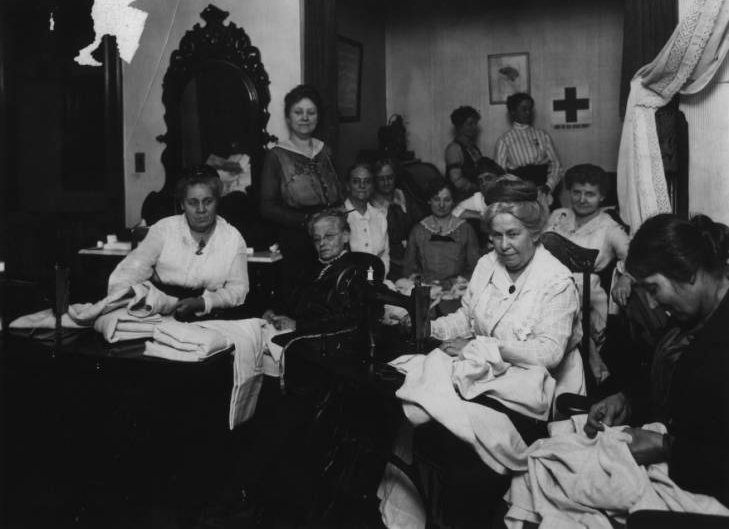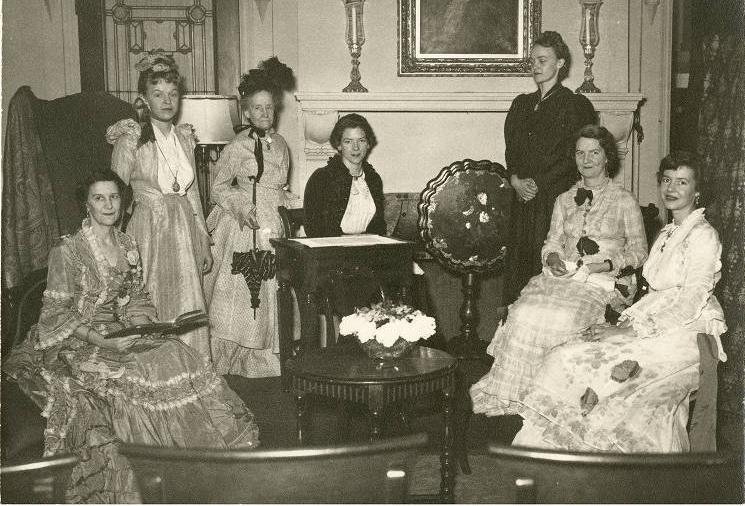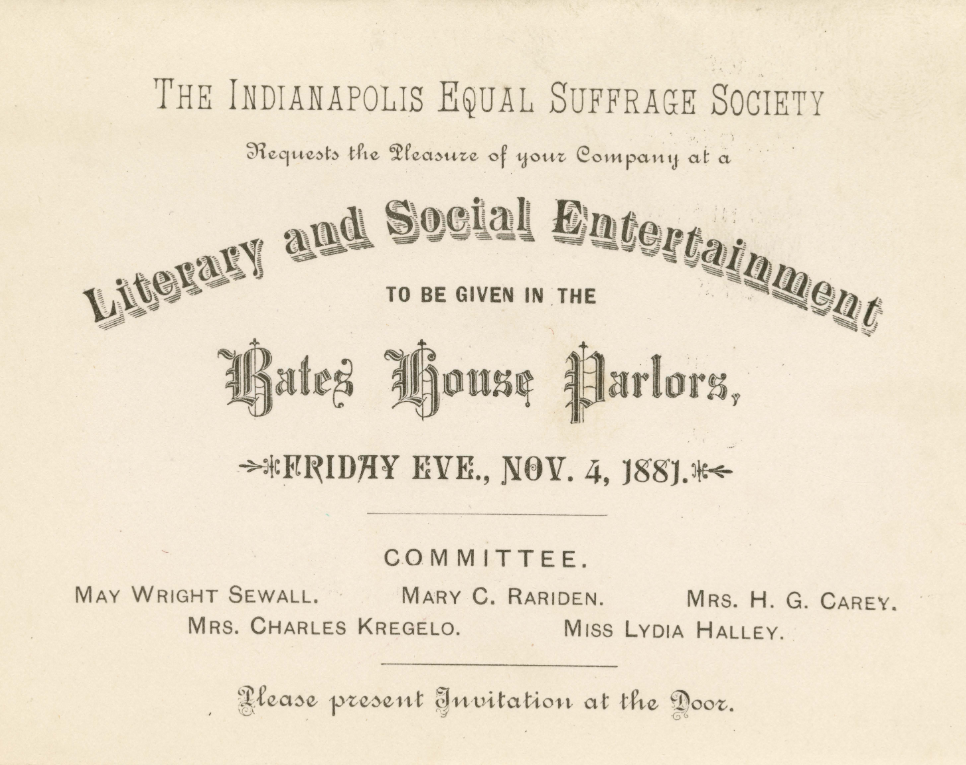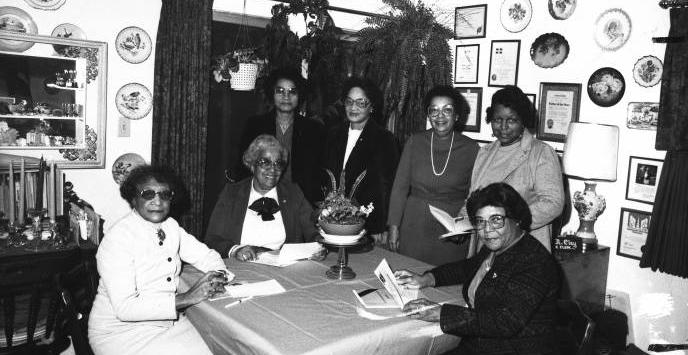Women have founded and volunteered for a wide range of recreational, educational, and charitable activities throughout Indiana history. Women’s benevolence fit socially into prescribed gender roles, limiting their participation to religious and charitable organizations, a respectable way for women to extend their moral guardianship of households into the community. Volunteer activities often awakened women’s intellectual and recreational interests and provided important voices in the cultural and philanthropic life of Indianapolis. Women developed skills and abilities that they transferred to the workplace and to civic affairs, thereby expanding the roles of women in society.

Prior to the Civil War, local women’s organizations focused on the care of vulnerable populations, such as the Widows’ and Orphans’ Friends Society (1850), which established the Indianapolis Orphans’ Asylum in 1866. Women joined auxiliaries of men’s fraternal organizations. The 1857 Indianapolis City Directory, for example, lists a chapter of the Daughters of Rebekah, the women’s counterpart to the Odd Fellows. Congregations had women’s groups that supported their own congregations, such as the Ladies Sewing Society of , the Hebrew Ladies Benevolent Society (1859), and the German Ladies Aid Society (1886). Women of different faiths worked together as well. The Ladies Society for the Relief of the Poor (1869), for example, enlisted both Catholic and Protestant members.
Causes such as temperance often derived from deep religious values, bringing about the local chapter of the in 1873. During the Civil War, women in Indianapolis organized to collect funds and items for soldiers at the front, supporting both the Indiana Sanitary Commission and the U.S. Sanitary Commission. The (1876), first established to bring flowers to the city’s hospitals, evolved into caring for sick women and children.
The U.S. witnessed an explosion in voluntarism when women looked for recreational and self-improvement activities as their educational levels and leisure time increased. Nationally women established study clubs, groups that met regularly to discuss topics ranging from literature to current events. Study clubs provided an opportunity to meet, hear presentations from fellow members, and develop skills in public speaking.
The first Indiana society was the (1875). Sometimes named after the day they met, such as the Monday Conversation Club (1897), and sometimes on a lighter note, like the Over the Teacups Club (1890), clubs adopted names descriptive of their purpose, such as the Woman’s Research Club (1899). Clubs were often organized by women with the same ethnic or religious backgrounds, such as the Catholic Women’s Proctor Club (1898) and the German Indianapolis Women’s Literary Club (1889).

Clubs often identified community issues and supported charitable efforts accordingly. The (1892) coordinated communication between the women’s clubs on projects involving civic welfare. Women established the (1877). The Daughters of the American Revolution founded its first chapter in the Indianapolis area in 1894 with the Caroline Scott Harrison Chapter. Female relatives of Civil War veterans joined the Women’s Relief Corps (1884), an auxiliary of the .
Women formed organizations associated with employment as they joined the workforce in increasing numbers, such as the Bookbinders Bindery Girls Union (ca. 1910). The (1895) provided housing, education, and a noontime lunch and rest area in the downtown area for young working women. The Mutual Aid Association (1903) assisted unfortunate working women by providing housing and financial assistance. The Southside Hebrew Ladies Sheltering House (1902), the Association (1883), and the Mother’s Aid Society (1907) reflected women’s long-standing interest in assisting vulnerable women.
Progressive-Era women looked to the structural causes of poverty and social problems and sought reform by lobbying the government. Under the banner of “municipal housekeeping,” these activities permitted women to expand traditional benevolence. Women used volunteer activities before suffrage to achieve social change, often by persuading the government to assume responsibility for it. Sixteen Indianapolis women’s clubs accordingly joined an umbrella organization, the Indiana General Federation of Women’s Clubs (1909).
Many women believed the best way to enact change was through the ballot box. The Indianapolis Equal Suffrage Society (1878), which eventually extended statewide, was an early advocacy organization for women’s right to vote. The Indianapolis Woman’s Franchise League (1911) took an active role in promoting women’s suffrage. After ratification of the 19th Amendment in 1920, women established the Indianapolis chapter of the (1920), which incorporated many of the previous suffrage groups and worked to educate the new voters. The Marion County Women’s Democratic Club (1921) and the Indianapolis Woman’s Republican Club (1922) provided outlets for women’s partisan political activities.

Indianapolis women established local chapters of national groups during the early 20th century, forming the (1913), girl scouts (1917), and the YMCA’s Girl Reserves (1920). Some groups were patterned after men’s service organizations such as the Altrusa Club (1917), Indianapolis Business and Professional Women’s Council (1914), Woman’s Rotary Club (1919), the (1922), and Zonta International (1929). African American women established a chapter of the National Council of Negro Women (1935). founded the Women’s Improvement Club (1903) and the local chapter of the National Association of Colored Women’s Club.
Women organized around domestic topics. The Indianapolis Housewife’s League (1919) sought to lower prices on foodstuffs and discussed the possibility of community kitchens. The Housewife’s League established local markets to purchase fresh food.

Women’s groups centered on specific institutions. The Methodist Hospital White Cross Guild (1931) (see ), The Children’s Museum Guild (1933), and the Women’s Symphony Committee (1937) for the provided financial support during the Great Depression. Women organized around shared recreational interests. The Indiana Chapter of the Ninety-Nines (1939), located in Indianapolis, was a group of women airplane pilots who sponsored airplane races locally and throughout the state. Women interested in motorcycles established the Harlyettes (1940), an auxiliary to the local Harley Motorcycle Club.
Women’s participation in the workforce grew rapidly during the World War II era. Men’s organizations provided business networking opportunities; women were usually excluded. They formed professional organizations locally, such as the Indianapolis Chapter, American Society of Women Accountants (1938), the Indianapolis Association of Insurance Women (1942), the Indianapolis Credit Women’s Breakfast Club (ca. 1954), and the Women’s Construction League of Indianapolis (1955).

Women established organizations focused primarily on political issues. Women for Better Government (1955) and the Women’s Civic Club (1962) worked within established political circles to advance issues of interest to women. The Woman’s AntiCrime Crusade joined the Mayor’s Task Force on Women to form Women United Against Rape (1973), the first group in the country to establish a 24-hour rape crisis center. This initiative survives today as the Center of Hope at Indianapolis hospitals.
The (1971) and a local chapter of the (NOW) were formed to support particular candidates and legislation. The Black Pearls (1969) began as a social and civic club for young African American women concerned with bettering conditions on .
Girls were a focus of volunteer activities with the creation of local chapters of Big Sisters (today ) (1974) and (1969). Alliance for Girls Services (1981) brought several local organizations like , and to provide mentoring and social services for young girls.
The (1975) opened to shelter survivors of domestic violence. (1996) and Dove House (2000) provide transitional housing and support services to survivors of interpersonal violence. Bellfound Farm (2018), a Women’s Fund of Central Indiana initiative, operates a residential urban farm to empower at-risk 18 to 24-year-old women to achieve economic independence. Dress for Success Indianapolis (1999) also prepares women for economic independence through networks of support and professional attire.
Women’s voluntary organizations in Indianapolis have reflected the diversity of women in the community and their recreational, educational, and charitable interests. As social expectations of women and their roles changed, so did the need for female-only groups. Increasingly, volunteer organizations coalesced around issues regardless of gender. The local chapter of the national organization Mothers Against Drunk Driving, for example, has both male and female members.
Throughout the city’s history, women’s groups have helped women develop leadership skills that they were able to use in changing the community. More contemporary organizations have been dedicated to aiding victims, namely women and children, of sexual and other violence. Most importantly, women’s volunteer organizations in Indianapolis have contributed numerous hours to improve the physical and social life of the community and have expanded society’s view about women’s participation in economic, political, and social matters.

Help improve this entry
Contribute information, offer corrections, suggest images.
You can also recommend new entries related to this topic.